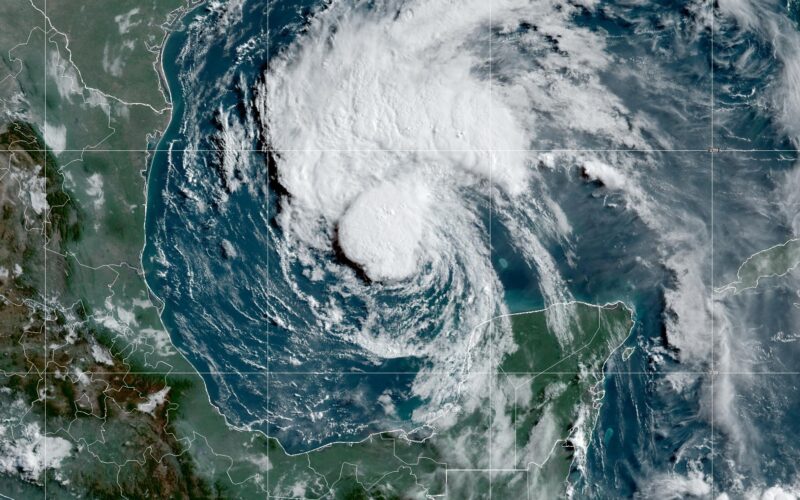GALVESTON — Tropical Storm Beryl thrashed Mexico’s Yucatan Peninsula on Friday after battering the resort town of Tulum and then entering the Gulf of Mexico. The National Hurricane Center predicted that Beryl would intensify on Saturday before making landfall, prompting expanded hurricane and storm surge watches.
“There is an increasing risk of damaging hurricane-force winds and life-threatening storm surge in portions of northeastern Mexico and the lower and middle Texas coast late Sunday and Monday,” the center warned.
State and local officials have urged coastal residents to be prepared for possible storm surge flooding, heavy rain and high winds. Some Texas cities called for voluntary evacuations in low-lying areas prone to flooding, banned beach camping and urged tourists traveling on the July 4 holiday weekend to move recreational vehicles from coastal parks.
Texas Lt. Gov. Dan Patrick, the acting governor while Governor Greg Abbott is traveling in Taiwan, issued a pre-emptive disaster declaration for 40 counties.
“Everyone along the (Texas) coast should be paying attention this storm,” Patrick said. “We hope and we pray for nothing more than a rain event.”
Beryl hit Tulum as a Category 2 hurricane and toppled trees but caused no injuries or deaths before weakening to a tropical storm as it moved across the peninsula.
As of Friday evening, Beryl was a tropical storm with maximum sustained winds of 60 mph. It was 615 miles southeast of Corpus Christi, Texas, headed northwest at 13 mph.
Beryl, the earliest storm to develop into a Category 5 hurricane in the Atlantic, caused at least 11 deaths as it passed through the Caribbean islands earlier in the week.
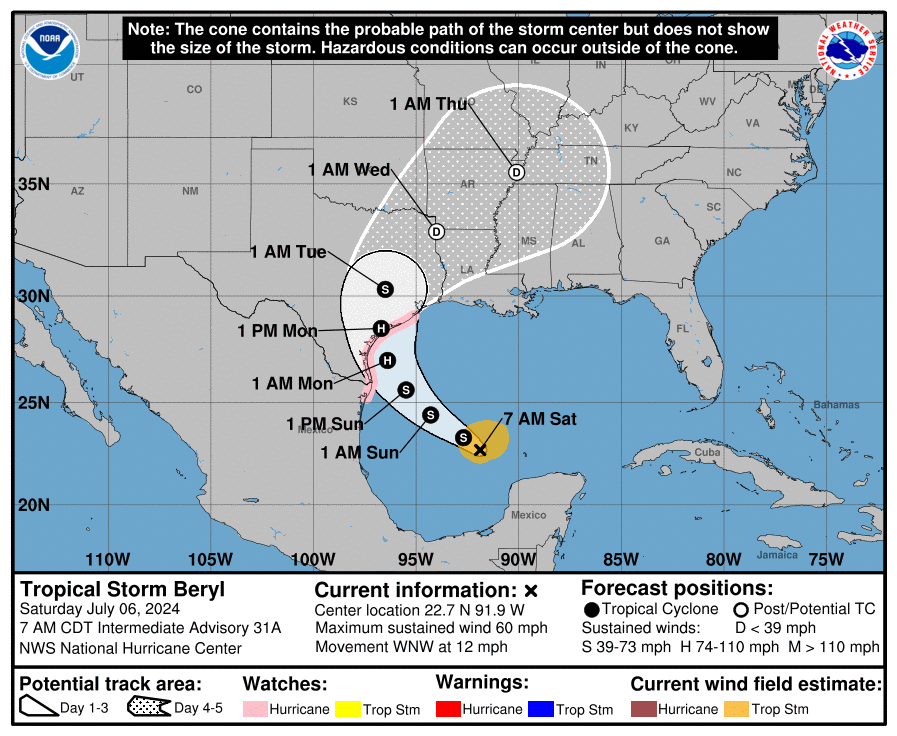
What is Beryl’s projected path?
Once in the Gulf, Beryl is expected to regain hurricane strength Saturday before aiming at the Texas coast. A hurricane watch was in effect in Texas from the Rio Grande along the coast to San Luis Pass, just south of Houston, and for Mexico’s northeastern coast from Barra el Mezquital to the Rio Grande.
“Hurricane conditions are possible in the hurricane watch area along the Gulf coast of northeastern Mexico and Texas by late Sunday,” the hurricane center said.
National Hurricane Center senior specialist Jack Beven said Beryl is likely to make landfall somewhere between Brownsville and a bit north of Corpus Christi Monday. The hurricane center forecasts it will hit as a strong Category 1 storm, but wrote “this could be conservative if Beryl stays over water longer” than expected.
The waters in the Gulf of Mexico are warm enough for the early-season storm to rapidly intensify, as it has several times before.
“We should not be surprised if this is rapidly intensifying before landfall and it could become a major hurricane,” said Weather Underground co-founder Jeff Masters, a former government hurricane meteorologist who flew into storms. “Category 2 may be more likely, but we should not dismiss a Category 3 possibility.”
Beven said the official forecast has Beryl gaining 17 to 23 mph in wind speed in 24 hours, but noted the storm intensified more rapidly than forecasters expected earlier in the Caribbean.
“People in southern Texas now need to really keep an eye on the progress of Beryl,” Beven said.
Some Texas counties have already issued voluntary evacuation orders in low-lying areas, and Texas officials urged coastal residents to prepare.
Along the Texas coast in Corpus Christi, city officials announced it had distributed 10,000 sandbags in less than two hours Friday, exhausting its supply.
Nim Kidd, chief of state emergency operations, said oil companies have started moving employees off rigs along the coast that may be in the path of the storm.
Northeastern Mexico and southern Texas were already soaked by Tropical Storm Alberto just a couple of weeks ago.
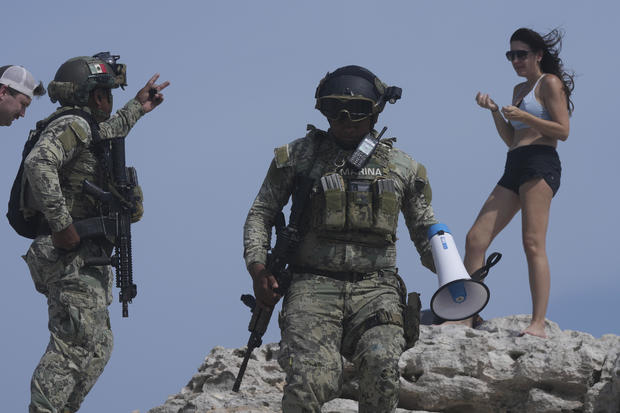
Soldiers ask a tourist to evacuate Mirador beach on July 4, 2024 ahead of Hurricane Beryl’s expected arrival in Tulum, Mexico.FERNANDO LLANO / AP
Mexico avoids major devastation from Beryl
The head of Mexico’s civil defense agency, Laura Velázquez, said Beryl hadn’t caused any deaths or injuries there and that “damages were minor,” though tens of thousands of people remained without power.
Tulum was plunged into darkness when the storm knocked out power as it came ashore. Screeching winds set off car alarms across the town. Wind and rain continued to whip the seaside city and surrounding areas Friday morning. Army brigades roved the streets of the tourist city, clearing fallen trees and power lines.
Although no dead or wounded have been reported, nearly half of Tulum continued to be without electricity, said Laura Velázquez, national coordinator of Mexican Civil Protection.
Before the storm hit Mexico, official had set up shelters in schools and hotels. When the wind began gusting over Tulum’s beaches Thursday, officials on four-wheelers with megaphones rolled along the sand telling people to leave and authorities evacuated beachside hotels. Sea turtle eggs were even moved off beaches threatened by storm surge.
Tourists also took precautions. Lara Marsters, 54, a therapist visiting Tulum from Boise, Idaho, said she had filled up empty water bottles from the tap.
“We’re going to hunker down and stay safe,” she said.
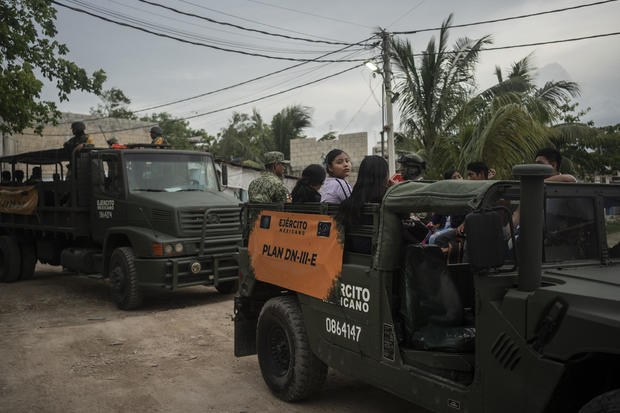
National Guard soldiers take people to an emergency shelter on July 4, 2024 on Mexico’s Yucatan Peninsula ahead of the expected arrival of Hurricane Beryl.FELIX MARQUEZ / PICTURE ALLIANCE VIA GETTY IMAGES
Beryl leaves trail of damage, destruction
While many in the Yucatan Peninsula took a deep breath, Jamaica and other islands ravaged by the hurricane were still reeling. As of Friday morning, 55% of Jamaica still without electricity and most of the country was without running water, according to government figures.
After seeing Beryl tear through the Caribbean, 37-year-old Lucía Nagera Balcaza was among those who stocked up on food and hid away in their homes.
“Thank god, we woke up this morning and everything was all right,” she said. “The streets are a disaster, but we’re out here cleaning up.”
Jamaican Prime Minister Andrew Holness promised swift relief for residents affected by Hurricane Beryl after visiting one of the worst-affected areas of the island, the southern parish of St Elizabeth on Thursday afternoon.
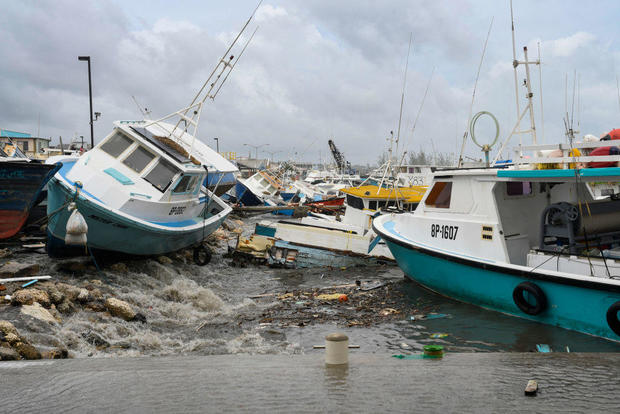
Damaged fishing boats rest on the shore after the passing of Hurricane Beryl at the Bridgetown Fish Market, Bridgetown, Barbados on July 1, 2024.RANDY BROOKS/AFP VIA GETTY IMAGES
“I know some of you are experiencing discomfort and displacement, and I want to assure you that the government will move as quickly as we can to get you the help you need,” he said.
Earlier in the week, the hurricane damaged or destroyed 95% of homes on a pair of islands in St. Vincent and the Grenadines, jumbled fishing boats in Barbados and ripped off roofs and knocked out electricity in Jamaica.
On Union Island, part of St. Vincent and the Grenadines, a man who identified himself as Captain Baga described the storm’s impact, including how he had filled two 2,000-gallon (7,570-liter) rubber water tanks in preparation.
“I strapped them down securely on six sides; and I watched the wind lift those tanks and take them away — filled with water,” he said Thursday. “I’m a sailor and I never believed wind could do what I saw it do. If anyone (had) ever told me wind could do that, I would have told them they lie!”
The island was littered with debris from homes that looked like they had exploded.
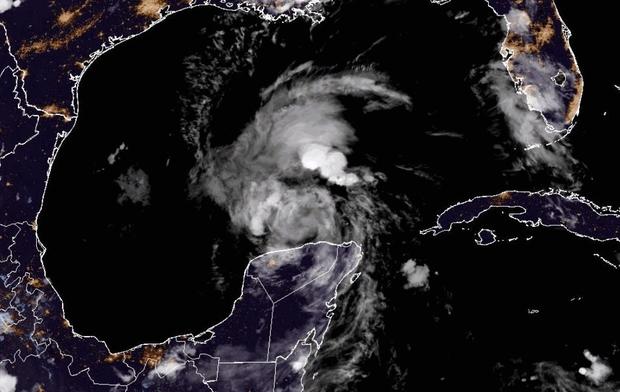
A satellite image of Tropical Storm Beryl in the Gulf of Mexico at 11 p.m. Eastern on July 4, 2024. NOAA
Historic hurricane
Beryl was the earliest Category 5 hurricane ever recorded in the Atlantic basin, and was only the second Category 5 storm recorded in July since 2005, according to the hurricane center.
It took Beryl only 42 hours to strengthen from a tropical depression to a major hurricane, which is a Category 3 storm or higher — a feat accomplished only six other times in Atlantic hurricane history, and with Sept. 1 as the earliest date, according to hurricane expert Sam Lillo.
Beryl was also the third Category 3 hurricane ever recorded in the Atlantic in June, following Audrey in 1957 and Alma in 1966, hurricane specialist and storm surge expert Michael Lowry said.
“Beryl is an extremely dangerous and rare hurricane for this time of year in this area,” he told the AP in a phone interview. “Unusual is an understatement,” he said, calling Beryl historic.
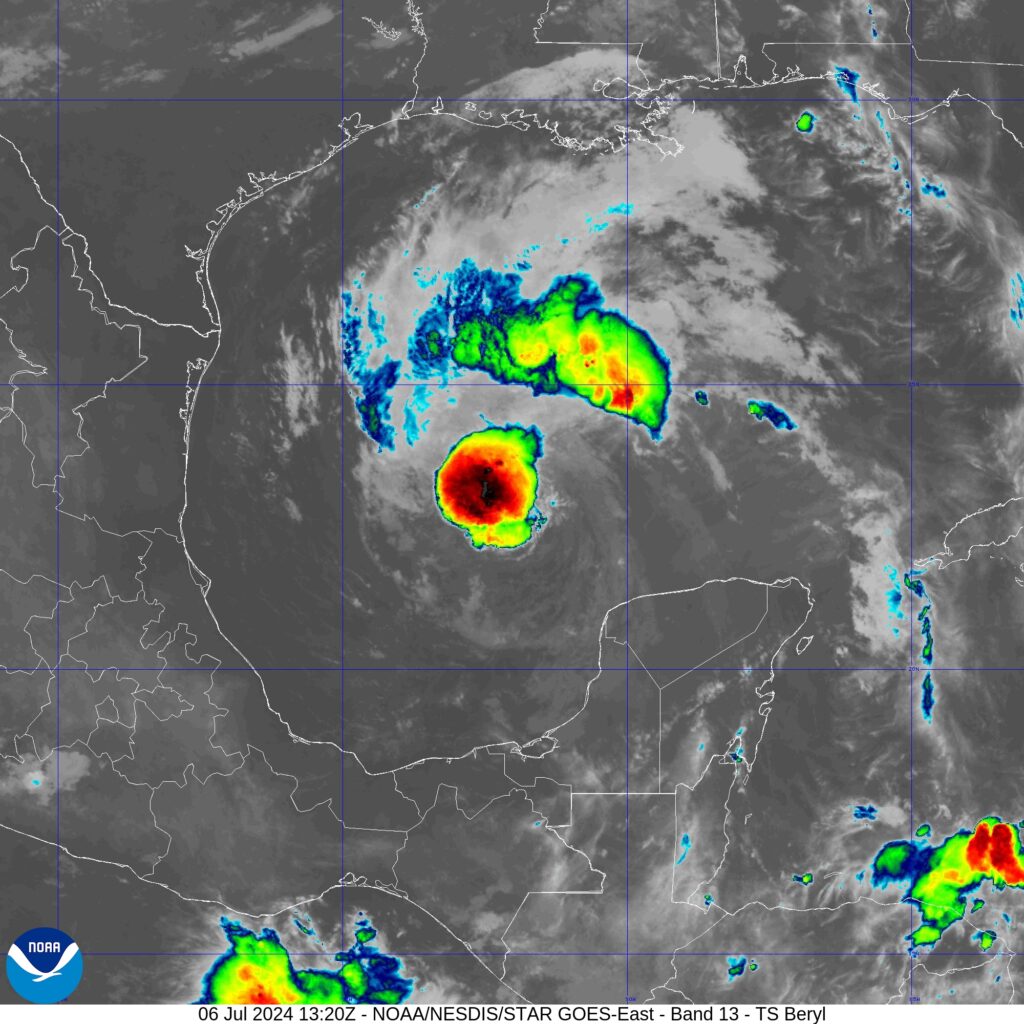
Hurricane Ivan in 2004 was the last strongest hurricane to hit the southeast Caribbean, causing catastrophic damage in Grenada as a Category 3 storm.
Beryl is the second named storm in what is predicted to be a busy hurricane season, which runs from June 1 to Nov. 30 in the Atlantic. Last month, Tropical Storm Alberto brought torrential flooding to portions of southern Texas and northeastern Mexico. It was responsible for at least four deaths in the Mexican states of Nuevo Leon and Veracruz.
According to CBS News weather producer David Parkinson, Beryl is the farthest east a hurricane has formed in June, and one of only two to do so east of the Caribbean, with the other instance occurring in 1933.
Warm waters fueled Beryl, with ocean heat content in the deep Atlantic the highest on record for this time of year, according to Brian McNoldy, University of Miami tropical meteorology researcher.
By CBS News

